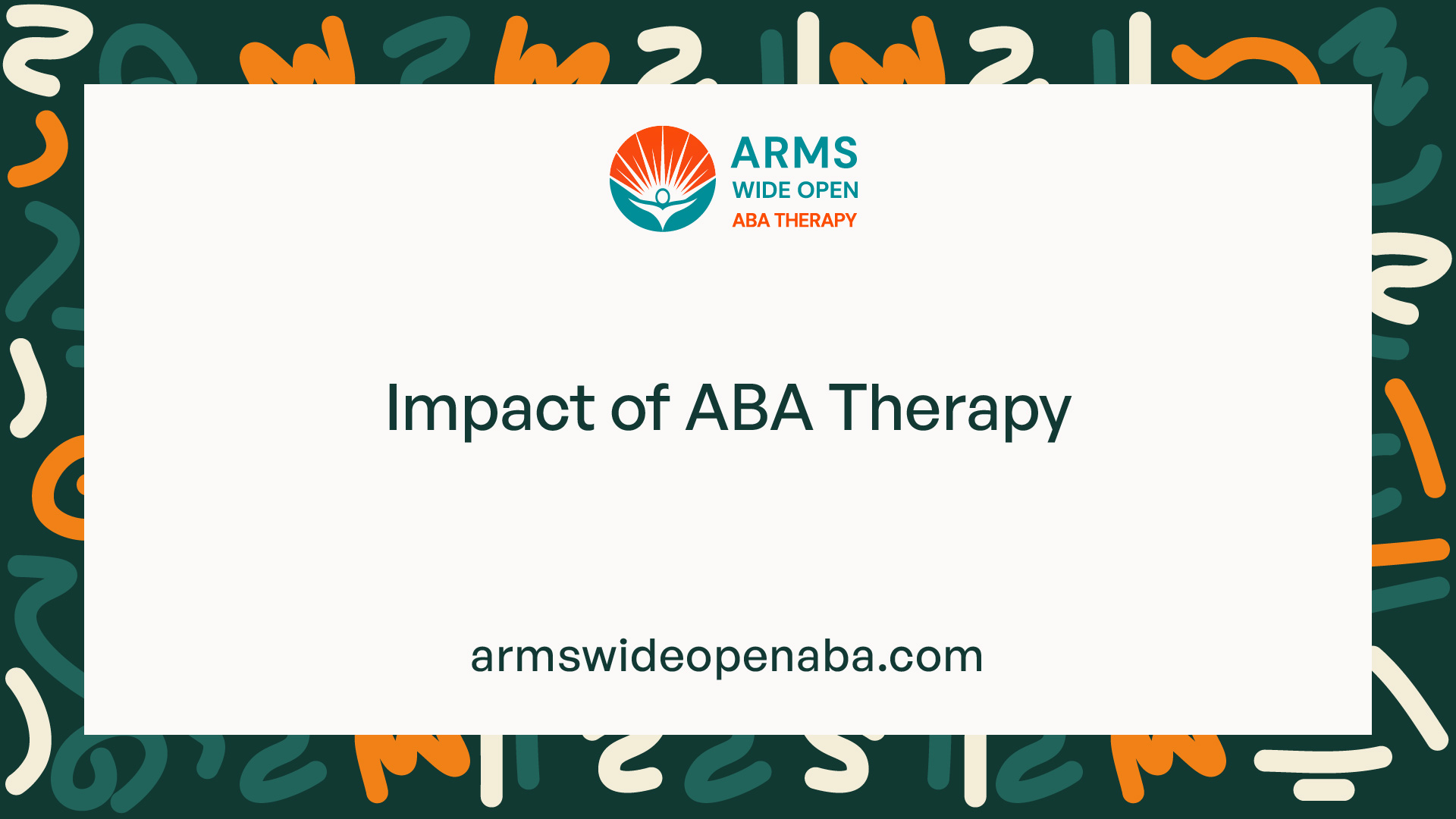What Do ABA Therapists Do?
Discover the impact of ABA therapists' work in unlocking potential. From behavior plans to collaboration, explore what ABA therapists do!


Understanding ABA Therapy
ABA therapy, or Applied Behavior Analysis therapy, is a scientifically proven approach used to improve behaviors and skills in individuals with autism spectrum disorder (ASD) and other developmental disabilities. ABA therapists play a crucial role in implementing this therapy and helping individuals reach their full potential.
What is ABA Therapy?
ABA therapy is a systematic and evidence-based approach that focuses on understanding and modifying behavior. It utilizes principles of learning and behavior to teach new skills, reduce problem behaviors, and promote positive behavior change. ABA therapy is tailored to the unique needs of each individual, and interventions are based on thorough assessments and data analysis.
ABA therapy can be applied in various settings, including homes, schools, and clinics. It targets a wide range of skills, such as communication, social interactions, self-care, and academic abilities. The ultimate goal of ABA therapy is to improve the individual's overall quality of life and increase their independence.
The Role of ABA Therapists
ABA therapists are highly trained professionals who implement ABA therapy techniques and strategies. They work closely with individuals with ASD or other developmental disabilities, as well as their families and caregivers. ABA therapists play a critical role in designing and implementing individualized treatment plans, tracking progress, and making necessary adjustments to achieve positive outcomes.
The responsibilities of ABA therapists include:
- Conducting assessments: ABA therapists conduct initial assessments to identify the individual's strengths, weaknesses, and specific needs. These assessments help in creating a baseline for behavior goals and intervention plans.
- Developing behavior plans: Based on the assessment results, ABA therapists develop behavior plans that outline specific goals and strategies to address the individual's behavioral challenges. These plans are tailored to the unique needs of each individual and are designed to promote positive behavior change.
- Implementing interventions: ABA therapists implement behavior intervention strategies and techniques outlined in the behavior plans. They use evidence-based practices to teach new skills, reinforce positive behaviors, and reduce problem behaviors. Interventions may involve structured teaching, prompting, shaping, and other behavior modification techniques.
- Collecting and analyzing data: ABA therapists collect data to track the progress of the individual. This data helps in evaluating the effectiveness of the interventions and making informed decisions regarding treatment adjustments. Data collection allows therapists to measure behavior change objectively and make evidence-based decisions.
- Collaborating with families and caregivers: ABA therapists work closely with families and caregivers to ensure consistency in implementing behavior plans across different environments. They provide guidance and support to help families understand and reinforce the strategies used during therapy sessions.
ABA therapists play a vital role in improving the lives of individuals with ASD and other developmental disabilities. Their expertise in ABA therapy techniques and their dedication to promoting positive behavior change make a significant impact on the individuals they work with.

A Day in the Life of an ABA Therapist
Being an ABA therapist is a rewarding and impactful profession that involves working closely with individuals to help them achieve their goals and improve their quality of life. A typical day in the life of an ABA therapist involves various tasks and responsibilities, including initial assessments, implementation of behavior plans, and data collection and analysis.
Initial Assessment and Goal Setting
At the beginning of the therapy journey, ABA therapists conduct initial assessments to gather information about the individual's behavior and identify areas of focus. These assessments may include interviews with the individual or their parents/caregivers, direct observations, and standardized assessments. Based on the assessment findings, ABA therapists collaborate with the individual and their support system to set specific and measurable goals.
During this stage, clear communication is crucial to ensure that everyone involved understands the goals and objectives of the therapy. ABA therapists work closely with the individual and their support system to develop a comprehensive treatment plan tailored to their unique needs.
Implementation of Behavior Plans
Once the goals are established, ABA therapists begin implementing behavior plans that are designed to target specific behaviors or skills. They use evidence-based techniques and strategies to teach new skills, reduce problem behaviors, and promote positive behaviors.
ABA therapists break down complex skills into smaller, manageable steps, implementing strategies such as prompting, shaping, and chaining to facilitate learning. They also utilize positive reinforcement to motivate and reward desired behaviors, helping the individual build new skills and habits.
Data Collection and Analysis
Data collection and analysis are fundamental components of ABA therapy. ABA therapists meticulously track and record data on the individual's progress, using various methods such as observation, checklists, and rating scales. This data allows therapists to measure the effectiveness of interventions, make informed decisions about treatment adjustments, and evaluate progress toward the established goals.
By analyzing the collected data, ABA therapists can identify patterns, trends, and areas that require further attention. They use this information to continuously refine and modify the behavior plan, ensuring that the therapy remains effective and aligned with the individual's needs and progress.
Data Collection Methods
Direct Observation
Checklists
Rating Scales
The day-to-day work of an ABA therapist is dynamic and multifaceted. Through initial assessments, goal setting, behavior plan implementation, and data collection and analysis, ABA therapists play a vital role in helping individuals with behavioral challenges achieve meaningful and lasting improvements in their lives.
Techniques Used by ABA Therapists
ABA therapists employ a variety of techniques to effectively support individuals through Applied Behavior Analysis (ABA) therapy. These techniques are designed to address specific behaviors and promote positive outcomes. Let's explore three key techniques commonly used by ABA therapists:
Applied Behavior Analysis Techniques
Applied Behavior Analysis techniques form the foundation of ABA therapy. These evidence-based techniques focus on understanding and modifying behavior by analyzing the relationship between an individual's actions and their environment. ABA therapists use various strategies, such as prompting, shaping, and fading, to teach new skills and encourage desirable behaviors. The goal is to identify the antecedents and consequences that influence behavior and implement interventions to promote positive change.
Positive Reinforcement Strategies
Positive reinforcement is a powerful tool used by ABA therapists to encourage desired behaviors. This technique involves providing rewards or incentives to reinforce positive actions, making it more likely that the behavior will be repeated in the future. By identifying what motivates an individual, ABA therapists can tailor the reinforcement to suit their preferences and needs. The use of positive reinforcement helps individuals to develop new skills and replace undesirable behaviors with more appropriate ones.
Individualized Treatment Plans
ABA therapy is highly individualized, and ABA therapists develop customized treatment plans for each person they work with. These treatment plans are created based on a comprehensive assessment of the individual's strengths, challenges, and specific goals. ABA therapists collaborate with the individual, their family, and other professionals to design interventions that address specific behavioral needs. The treatment plan outlines the strategies, techniques, and goals that will guide the therapy process, ensuring that the therapy is tailored to the unique needs of the individual.
To track progress and make data-driven decisions, ABA therapists use data collection and analysis methods. They record behavioral data during therapy sessions to monitor progress, identify patterns, and make adjustments to the treatment plan as needed. This data-driven approach allows ABA therapists to continually evaluate the effectiveness of their interventions and make informed decisions to support positive behavioral change.
By utilizing these techniques, ABA therapists can make a significant impact on the lives of individuals receiving therapy. Applied Behavior Analysis techniques, positive reinforcement strategies, and individualized treatment plans work together to promote positive behavior change, enhance skill development, and improve overall quality of life.

Impact of ABA Therapy
ABA therapy, or Applied Behavior Analysis therapy, has a profound impact on individuals receiving treatment. ABA therapists utilize evidence-based techniques to address challenging behaviors and promote positive change. Let's explore some of the key impacts of ABA therapy.
Improving Behavior and Social Skills
One of the primary goals of ABA therapy is to improve behavior and social skills in individuals. ABA therapists work closely with their clients to identify target behaviors and develop behavior intervention plans. Through the use of various techniques, such as reinforcement strategies and behavior modification, ABA therapy helps individuals learn new skills and replace undesirable behaviors with more appropriate ones.

Promoting Independence and Communication
Another significant impact of ABA therapy is the promotion of independence and communication skills. ABA therapists work on developing functional communication skills, including verbal and non-verbal communication, to enhance individuals' ability to express their needs and wants effectively. Through structured teaching methods, individuals learn to follow instructions, engage in reciprocal conversations, and engage in age-appropriate social interactions.

Enhancing Quality of Life
ABA therapy has a significant impact on enhancing the overall quality of life for individuals receiving treatment. By addressing challenging behaviors, developing social skills, and promoting independence, ABA therapy helps individuals lead more fulfilling and meaningful lives. The skills learned through therapy extend beyond the therapy sessions and have a positive influence on various aspects of daily living, including academic performance, personal relationships, and community participation.

The impact of ABA therapy extends far beyond behavior change. By improving behavior and social skills, promoting independence and communication, and enhancing overall quality of life, ABA therapists play a vital role in helping individuals reach their full potential. Through their dedication and expertise, ABA therapists empower individuals to lead more fulfilling and independent lives.
Collaboration in ABA Therapy
Collaboration is a key aspect of ABA therapy, as it involves working closely with families, caregivers, and a multidisciplinary team to ensure the best outcomes for individuals receiving therapy. By fostering collaboration, ABA therapists are able to provide comprehensive and effective treatment plans. Let's explore the different elements of collaboration in ABA therapy.
Working with Families and Caregivers
ABA therapists recognize the significant role that families and caregivers play in the success of therapy. They actively involve and engage families in the treatment process, ensuring open lines of communication and collaboration. By working closely with families, ABA therapists gain valuable insights into the individual's unique needs, preferences, and goals. This collaboration allows for the development of personalized treatment plans that align with the individual's home environment and daily routines.
Therapists also provide guidance and support to families, equipping them with strategies and techniques to implement ABA principles outside of therapy sessions. This collaboration empowers families and caregivers to reinforce positive behaviors and generalize skills, promoting consistency and progress beyond the therapy setting.
Interdisciplinary Team Approach
In addition to collaboration with families and caregivers, ABA therapists often work within interdisciplinary teams. These teams may include professionals such as speech therapists, occupational therapists, psychologists, and educators. By collaborating with other professionals, ABA therapists gain a holistic understanding of the individual's needs and can develop comprehensive treatment plans that address various aspects of their development.
Interdisciplinary collaboration allows for the sharing of expertise and perspectives, fostering a well-rounded approach to therapy. Through regular team meetings and coordination, professionals can align their efforts, share progress updates, and adjust treatment strategies as needed. This interdisciplinary approach ensures that the individual receives comprehensive support, addressing their behavioral, educational, communication, and social needs.
Continuous Professional Development
ABA therapists recognize the importance of ongoing learning and continuous professional development. They actively seek opportunities to expand their knowledge, stay updated with the latest research and best practices, and enhance their skills. This dedication to professional growth enables therapists to provide the highest quality of care and support to individuals undergoing ABA therapy.
By attending conferences, workshops, and trainings, ABA therapists stay informed about advancements in the field and gain new tools and techniques to improve their practice. They also collaborate with colleagues, participating in case consultations and peer supervision, to share experiences and learn from each other. This commitment to continuous professional development ensures that therapists maintain a strong foundation of knowledge and provide evidence-based interventions.
Collaboration is a cornerstone of ABA therapy, involving working closely with families, caregivers, and interdisciplinary teams. By fostering collaboration, ABA therapists create a supportive environment that maximizes the potential for positive outcomes. Through collaboration, families receive the guidance and support they need, while therapists benefit from the expertise and perspectives of their colleagues. This collective effort allows for comprehensive and effective ABA therapy that promotes growth, independence, and improved quality of life for individuals receiving treatment.
Sources
https://online.regiscollege.edu/blog/where-do-therapists-work/
https://www.autismspeaks.org/applied-behavior-analysis
https://www.webmd.com/mental-health/what-is-applied-behavior-analysis
Similar articles
We’re here to help you

Our team is here to assist you in this process. Contact us for any assistance.
it’s easy to apply
We Accept Most Insurances
Our in-network insurance partnerships make ABA therapy more accessible to families throughout our service areas.







Our Insurance Process
We'll request your insurance details to help us verify your plan's coverage for ABA therapy. Once we've received this information, we'll walk you through your benefits, including copayments, deductibles and out-of-pocket maximums, so you know what to expect in advance.
Our team will then handle the preauthorization and all the necessary paperwork.
.svg)




















.jpeg)


































.jpeg)




.jpeg)







.jpeg)











.jpeg)
















